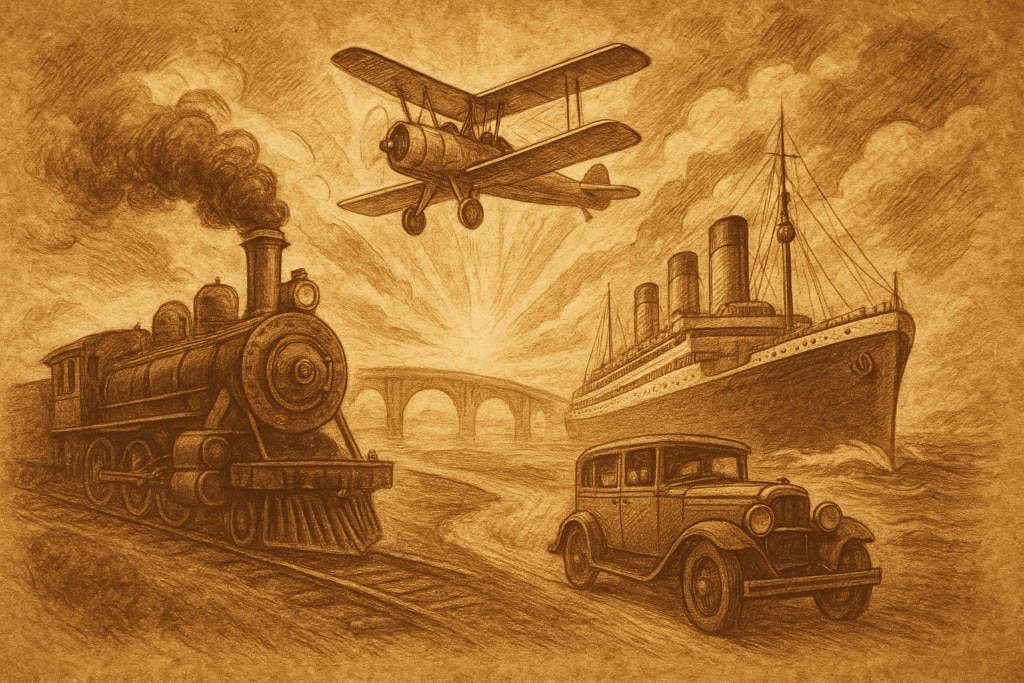Imran Ahsan Karim-Mirza, Australia

Numerous verses in the Holy Quran allude to the emergence of advanced means of transportation – signs of a future age marked by human ingenuity and divine unfolding. These verses, some speaking in plain terms and others rich in metaphor and meaning, invite contemplation on the evolution of mobility and the interconnectedness of our modern world. Such verses of the Holy Quran include:
وَّالۡخَیۡلَ وَالۡبِغَالَ وَالۡحَمِیۡرَ لِتَرۡکَبُوۡہَا وَزِیۡنَۃً ؕ وَیَخۡلُقُ مَا لَا تَعۡلَمُوۡنَ
“And [He has created] horses and mules and asses that you may ride them, and as [a source of] beauty. And He will create what you do not yet know.” (Surah an-Nahl, Ch.16: V.9)
وَاَذِّنۡ فِی النَّاسِ بِالۡحَجِّ یَاۡتُوۡکَ رِجَالًا وَّعَلٰی کُلِّ ضَامِرٍ یَّاۡتِیۡنَ مِنۡ کُلِّ فَجٍّ عَمِیۡقٍ
“And proclaim unto mankind the Pilgrimage. They will come to thee on foot, and on every lean camel, coming by every distant track.” (Surah al-Hajj, Ch.22: V.28)
رَبُّکُمُ الَّذِیۡ یُزۡجِیۡ لَکُمُ الۡفُلۡکَ فِی الۡبَحۡرِ لِتَبۡتَغُوۡا مِنۡ فَضۡلِہٖ ؕ اِنَّہٗ کَانَ بِکُمۡ رَحِیۡمًا
“Your Lord is He Who drives for you the ships in the sea, that you may seek of His bounty. Surely, He is merciful toward you.” (Surah Bani Isra’il, Ch.17: V.67)
The advancements of our age have revolutionised human mobility, as foretold nearly 1,400 years ago. This aligned with prophetic insights that hinted at the acceleration of global connectivity during the time of the Promised Messiah. Allow me to offer a summary of this remarkable era of modern transportation.
The advent of modern mobility
Trains and railway
The first public passenger railway in the world – the Stockton and Darlington Railway – opened in England in 1825, a full decade before the birth of Hazrat Mirza Ghulam Ahmad, the Promised Messiahas. This milestone marked the beginning of a new chapter in human movement, one that would soon extend across continents. (See The Origins of Railway Enterprise: The Stockton and Darlington Railway, 1821–1863)
The Holy Quran describes this in beautifully subtle terms:
وَاِذَا الۡعِشَارُ عُطِّلَتۡ
“And when the she-camels, ten-month pregnant, are abandoned.” (Surah at-Takwir, Ch.81: V.5)
In India, the inaugural passenger train journey took place on 16 April 1853, covering a distance of 34 kilometres between Bombay (now Mumbai) and Thane. Operated by the Great Indian Peninsula Railway, the train comprised 14 carriages and carried approximately 400 passengers, powered by three locomotives. This event signified the birth of railway transport on the Indian subcontinent.
The town of Qadian, the birthplace of the Promised Messiahas, eventually became part of this expanding network. The Qadian-Butari railway line was approved in 1927 and reached Qadian on 14 November 1928, further integrating the region into the broader transportation grid, and the first train reached on 19 December 1928.
Automobiles and roadway
The evolution of commercial vehicles began in the early 20th century. In 1917, Ford introduced the Model T, one of the first purpose-built commercial vehicles, paving the way for the widespread use of automobiles for transporting goods and people. By the 1910s, gasoline-powered cars had become dominant, prompting significant infrastructure changes.
Roads, once designed for horse-drawn carriages and foot traffic, were reimagined in the 1920s to accommodate the growing popularity of motor vehicles. (See Ford Tractors by Randy Leffingwell) Today, almost every major developed nation boasts a meticulously structured network of roadways spanning thousands of kilometres.
Aviation
Aviation also saw its genesis during this transformative period. During the lifetime of the Promised Messiahas, on 17 December 1903, in the windswept dunes of Kitty Hawk, North Carolina, the world witnessed a moment that would forever alter the course of human history.
It was on this day that the Wright brothers, Orville and Wilbur, achieved the first sustained, controlled, and powered flight of a heavier-than-air aircraft. Their creation, the Wright Flyer, lifted off the ground and soared for 12 seconds, covering a distance of 120 feet – an extraordinary feat that marked the dawn of modern aviation.
The world’s first commercial passenger flight occurred on 1 January 1914, when Tony Jannus piloted the Benoist XIV airboat, carrying Abram C Pheil, the former mayor of St. Petersburg, across a 21-mile journey to Tampa in just 23 minutes. This flight marked the beginning of scheduled commercial air travel.
Regarding the Latter Days, the Holy Prophet Muhammadsa said that at that time, “The Dajjal will ride a donkey that shines like the moon, and the distance between its ears will be seventy fathoms.” (Mishkat al-Masabih, Kitab al-fitan, Hadith 5493)
Another narration reads, “The ears of the Dajjal’s donkey will cast a shadow over seventy thousand people.” (Ad-Durr al-Manthur fi Tafsir bil Ma’thur, Vol. 7, p. 299) Then, it is also stated, “The transportation of Dajjal will have lights inside, it will have many doors and windows.” (Bihar al-Anwar, Vol. 52, p. 192)
Today, the scale of global air transportation is staggering. Approximately 100,000 commercial flights take off and land around the world each day, with over 90,000 dedicated to passenger travel. These flights carry millions of people daily, connecting cities, cultures, and economies in ways unimaginable even in the nineteenth century.
Modern ships
The imagery of boats and ships also appears frequently throughout the Holy Quran, often symbolising salvation, journey, and divine purpose. For example, the Quran states:
وَلَهُ الۡجَوَارِ الۡمُنۡشَئٰتُ فِی الۡبَحۡرِ کَالۡاَعۡلَامِ
“And His are the lofty ships reared aloft on the sea like mountains.” (Surah ar-Rahman, Ch.55: V.25)
Yet, in the modern age, these vessels have evolved far beyond their ancient forms, becoming marvels of engineering and cornerstones of global commerce and connectivity. Today, the world witnesses the operation of the largest passenger and cargo ships in history, a testament to human ingenuity and the scale of modern civilisation.
Cargo ships alone transport approximately 11 billion tons of goods annually, encompassing everything from raw materials to finished products. In the realm of leisure and travel, passenger ships have also reached unprecedented grandeur.
In 2024, approximately 34.6 million cruise passengers embarked on ocean voyages worldwide. At the forefront stands the Icon of the Seas, operated by Royal Caribbean – the largest passenger ship ever built. With a gross tonnage of 248,336, a length of 365 metres (1,198 feet), and a capacity to carry up to 7,600 passengers, it is a floating city, embodying luxury and scale.
Military maritime power has also surged. The USS Gerald R. Ford (CVN-78), the largest military ship in the world, is a nuclear-powered aircraft carrier of the United States Navy. Displacing over 100,000 tons at full load, it represents the pinnacle of naval technology and strategic capability. Globally, there are over 3,351 large military vessels, including aircraft carriers, destroyers, and submarines, operated by many superpowers and regional forces.
Interestingly, the Promised Messiahas was told of an age of unprecedented warfare in the seas. Allah revealed to him:
کَشتیاں چلتی ہیں تا ہوں کُشتیاں
“Boats sail so that there might be naval actions.” (Tadhkirah [English], 2018, p. 851)
A final word
The realm of modern mobility is undergoing a profound transformation, propelled by the rapid advancement of driverless vehicles, artificial intelligence, and digitally integrated transport ecosystems. This convergence of innovation marks the dawn of a new era – one poised to redefine how we move, connect, and interact with our surroundings.
This new age has drawn humanity closer than ever before. We traverse continents with ease, move fluidly within regions, and inhabit cosmopolitan cities where cultures converge and boundaries blur. We are more connected to friends, to strangers, to ideas than at any other point in human history. The Holy Quran accurately describes this:
وَاِذَا الۡبِحَارُ سُجِّرَتۡ وَاِذَا النُّفُوۡسُ زُوِّجَتۡ
“And when the seas are made to flow forth one into the other, and when people are brought together.” (Surah at-Takwir, Ch.81: V.7-8)
Yet, this unprecedented connectivity brings with it a duality: the challenge of conflict and the opportunity for collaboration. It is a moral crossroads, where technological advancement must be matched by ethical foresight.
As we build systems that move us faster and farther, we must also ask: What kind of world are we moving toward? In this age of intelligent mobility, the journey is no longer just physical – it has to be spiritual too. And the choices we make today will shape not only how we move, but how we live, together.

